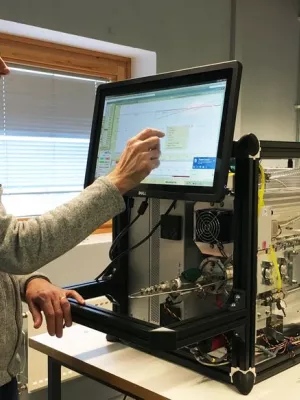
Erik Swietlicki
Professor

A European aerosol phenomenology - 6 : Scattering properties of atmospheric aerosol particles from 28 ACTRIS sites
Författare
Summary, in English
This paper presents the light-scattering properties of atmospheric aerosol particles measured over the past decade at 28 ACTRIS observatories, which are located mainly in Europe. The data include particle light scattering (σsp) and hemispheric backscattering (σbsp) coefficients, scattering Ångström exponent (SAE), backscatter fraction (BF) and asymmetry parameter (g). An increasing gradient of σsp is observed when moving from remote environments (arctic/mountain) to regional and to urban environments. At a regional level in Europe, σsp also increases when moving from Nordic and Baltic countries and from western Europe to central/eastern Europe, whereas no clear spatial gradient is observed for other station environments. The SAE does not show a clear gradient as a function of the placement of the station. However, a west-to-east-increasing gradient is observed for both regional and mountain placements, suggesting a lower fraction of fine-mode particle in western/south-western Europe compared to central and eastern Europe, where the fine-mode particles dominate the scattering. The g does not show any clear gradient by station placement or geographical location reflecting the complex relationship of this parameter with the physical properties of the aerosol particles. Both the station placement and the geographical location are important factors affecting the intraannual variability. At mountain sites, higher σsp and SAE values are measured in the summer due to the enhanced boundary layer influence and/or new particle-formation episodes. Conversely, the lower horizontal and vertical dispersion during winter leads to higher σsp values at all low-altitude sites in central and eastern Europe compared to summer. These sites also show SAE maxima in the summer (with corresponding g minima). At all sites, both SAE and g show a strong variation with aerosol particle loading. The lowest values of g are always observed together with low σsp values, indicating a larger contribution from particles in the smaller accumulation mode. During periods of high σsp values, the variation of g is less pronounced, whereas the SAE increases or decreases, suggesting changes mostly in the coarse aerosol particle mode rather than in the fine mode. Statistically significant decreasing trends of σsp are observed at 5 out of the 13 stations included in the trend analyses. The total reductions of σsp are consistent with those reported for PM2.5 and PM10 mass concentrations over similar periods across Europe.
Avdelning/ar
- Fysiska institutionen
- MERGE: ModElling the Regional and Global Earth System
Publiceringsår
2018-06-05
Språk
Engelska
Sidor
7877-7911
Publikation/Tidskrift/Serie
Atmospheric Chemistry and Physics
Volym
18
Issue
11
Dokumenttyp
Artikel i tidskrift
Förlag
Copernicus GmbH
Ämne
- Meteorology and Atmospheric Sciences
Status
Published
ISBN/ISSN/Övrigt
- ISSN: 1680-7316